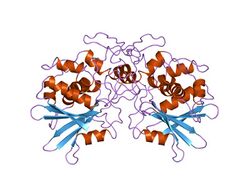Biology:Ribosome-inactivating protein
| Ribosome-inactivating protein | |||||||||||
|---|---|---|---|---|---|---|---|---|---|---|---|
 Structure of pokeweed antiviral protein.[1] | |||||||||||
| Identifiers | |||||||||||
| Symbol | RIP | ||||||||||
| Pfam | PF00161 | ||||||||||
| InterPro | IPR001574 | ||||||||||
| PROSITE | PDOC00248 | ||||||||||
| SCOP2 | 1paf / SCOPe / SUPFAM | ||||||||||
| |||||||||||
A ribosome-inactivating protein (RIP) is a protein synthesis inhibitor that acts at the eukaryotic ribosome.[2] This protein family describes a large family of such proteins that work by acting as rRNA N-glycosylase (EC 3.2.2.22). They inactivate 60S ribosomal subunits by an N-glycosidic cleavage, which releases a specific adenine base from the sugar-phosphate backbone of 28S rRNA.[3][4][5] RIPs exist in bacteria and plants.[6]
Members of the family include shiga toxins, and type I (e.g. trichosanthin and luffin) and type II (e.g. ricin, agglutinin, and abrin) ribosome inactivating proteins (RIPs). All these toxins are structurally related. RIPs have been of considerable interest because of their potential use, conjugated with monoclonal antibodies, as immunotoxins to treat cancers. Further, trichosanthin has been shown to have potent activity against HIV-1-infected T cells and macrophages.[7] Elucidation of the structure-function relationships of RIPs has therefore become a major research effort. It is now known that RIPs are structurally related. A conserved glutamic residue has been implicated in the catalytic mechanism;[8] this lies near a conserved arginine, which also plays a role in catalysis.[9]
Only a minority of RIPs are toxic to humans when consumed, and proteins of this family are found in the vast majority of plants used for human consumption, such as Rice, Maize and Barley. In plants, they are thought to defend against pathogens and insects.[10]
Ribosome-inactivating proteins (RIPs) are separated into the following types based on protein domain composition:[11]
- Type I (A): RIPs-I are polypeptides composed of an A domain. This is the site of N-glycosidase activity.
- Type II (AB): RIPs-II are composed of an A domain with similar catalytic activity to Type I RIPs, and a B domain with carbohydrate-binding (lectin) properties. The B domain is able to bind galactosyl moieties on the cell surface which facilitates entry into the cell, thus making Type II particularly cytotoxic. The A and B domains are fused together by disulfide bonds.[11][12] This group excludes bacterial AB5 toxins such as Shiga toxin, as the carbohydrate-binding ability evolved separately and these toxins are more similar to type I RIPs.[11]
- Type III: RIPs-III are separated into two subgroups. One subgroup (AC) contains the same original RIP domain (A), and a C-terminal with unknown functionality. The other subgroup (AD) is similar to Type I, but contains a site for inactivation.[11]
Examples include:
- Abrin
- Beetin
- Ricin
- Saporin
- Shiga toxin
- A Spiroplasma toxin[13]
- Trichosanthin
- Viscumin (European mistletoe)
- Pokeweed antiviral protein (Phytolacca americana)[14]
References
- ↑ "The 2.5 A structure of pokeweed antiviral protein". Journal of Molecular Biology 233 (4): 705–15. October 1993. doi:10.1006/jmbi.1993.1547. PMID 8411176.
- ↑ Ribosome+Inactivating+Proteins at the US National Library of Medicine Medical Subject Headings (MeSH)
- ↑ "Site of action of a Vero toxin (VT2) from Escherichia coli O157:H7 and of Shiga toxin on eukaryotic ribosomes. RNA N-glycosidase activity of the toxins". European Journal of Biochemistry 171 (1–2): 45–50. January 1988. doi:10.1111/j.1432-1033.1988.tb13756.x. PMID 3276522.
- ↑ "Ribosome inactivation by ricin A chain: a sensitive method to assess the activity of wild-type and mutant polypeptides". The EMBO Journal 8 (1): 301–8. January 1989. doi:10.1002/j.1460-2075.1989.tb03377.x. PMID 2714255.
- ↑ "Conserved amino acid residues in ribosome-inactivating proteins from plants". Biochimie 73 (7–8): 1157–61. 1991. doi:10.1016/0300-9084(91)90160-3. PMID 1742358.
- ↑ "Structure-function study of maize ribosome-inactivating protein: implications for the internal inactivation region and the sole glutamate in the active site". Nucleic Acids Research 35 (18): 6259–67. 2007. doi:10.1093/nar/gkm687. PMID 17855394.
- ↑ "Structure of trichosanthin at 1.88 A resolution". Proteins 19 (1): 4–13. May 1994. doi:10.1002/prot.340190103. PMID 8066085.
- ↑ "Evidence that glutamic acid 167 is an active-site residue of Shiga-like toxin I". Proceedings of the National Academy of Sciences of the United States of America 85 (8): 2568–72. April 1988. doi:10.1073/pnas.85.8.2568. PMID 3357883. Bibcode: 1988PNAS...85.2568H.
- ↑ "The 2.5 A structure of pokeweed antiviral protein". Journal of Molecular Biology 233 (4): 705–15. October 1993. doi:10.1006/jmbi.1993.1547. PMID 8411176.
- ↑ Zhu, Feng; Zhou, Yang-Kai; Ji, Zhao-Lin; Chen, Xiao-Ren (9 February 2018). "The Plant Ribosome-Inactivating Proteins Play Important Roles in Defense against Pathogens and Insect Pest Attacks". Frontiers in Plant Science 9: 146. doi:10.3389/fpls.2018.00146. PMID 29479367.
- ↑ Jump up to: 11.0 11.1 11.2 11.3 "Ribosome Inactivating Proteins from an evolutionary perspective". Toxicon 136: 6–14. September 2017. doi:10.1016/j.toxicon.2017.06.012. PMID 28651991.
- ↑ Fredriksson, Sten-Åke; Artursson, Elisabet; Bergström, Tomas; Östin, Anders; Nilsson, Calle; Åstot, Crister (December 2014). "Identification of RIP-II Toxins by Affinity Enrichment, Enzymatic Digestion and LC-MS". Analytical Chemistry 87 (2): 967–974. doi:10.1021/ac5032918. ISSN 0003-2700. PMID 25496503.
- ↑ "A ribosome-inactivating protein in a Drosophila defensive symbiont". Proceedings of the National Academy of Sciences of the United States of America 113 (2): 350–5. January 2016. doi:10.1073/pnas.1518648113. PMID 26712000. Bibcode: 2016PNAS..113..350H.
- ↑ "Pokeweed antiviral protein, a ribosome inactivating protein: activity, inhibition and prospects". Toxins 7 (2): 274–98. January 2015. doi:10.3390/toxins7020274. PMID 25635465.
 |

